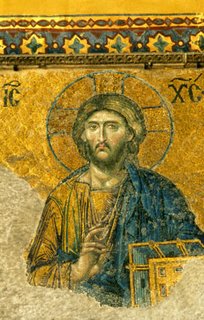Hagia Sophia

One of the things I liked best about college was the study of art history, and one of the most enduring memories I have in that area is of Hagia Sophia.
The church, built and completed in 537 in Constantinople, was the project of the Byzantine Emperor Justinian I, known as the last Roman Emperor and a saint of the Orthodox Church. Hagia Sophia was converted to a mosque in 1453, when the city fell to the Ottoman Turks, and was converted into a museum in 1935.
... Hagia Sophia is one of the greatest surviving examples of Byzantine architecture. Of great artistic value was its decorated interior with mosaics and marble pillars and coverings. The temple itself was so richly and artistically decorated that Justinian is said to have proclaimed "Solomon, I have surpassed thee!" (Νενίκηκά σε Σολομών). Justinian himself had overseen the completion of the greatest cathedral ever built up to that time, and it was to remain the largest cathedral for 1,000 years up until the completion of the cathedral in Seville. Justinian's basilica was at once the culminating architectural achievement of late antiquity and the first masterpiece of Byzantine architecture. Its influence, both architecturally and liturgically, was widespread and enduring in the Eastern Orthodox, Roman Catholic, and Muslim worlds alike. The dome of the Hagia Sophia has spurred particular interest for many art historians and architects because of the innovative way the original architects envisioned the dome ..... Restoration work in the 20th century began in 1932 by the American Byzantine Institute, when most of the figures were uncovered. In 1935, under the order of Turkish president Kemal Atatürk, Hagia Sophia was secularized and turned into the Ayasofya Museum. Due to its long history as both a church and a mosque, a particular challenge arises in the restoration process. The Christian iconographic mosaics are being gradually uncovered. However, in order to do so, important, historic Islamic art would have to be destroyed. Restorers have attempted to maintain a balance between both Christian and Islamic cultures.
- Wikipedia
Some photos of the interior (click to see enlargements)...


- Mosaic of Christ Pantocrator.

- Mosaic of Saint John Chrysostom.

- The dome undergoing restoration.
****
Read what Procopios wrote of Hagia Sophia here.
Read the novel about Justinian's famous general, Count Belisarius by Robet Graves


15 Comments:
Beautiful images and valuable links Crystal...I liked the novel of Robert Graves...I remember that at the history lessons we were told that the fall of Constatinopole was one of the greatest tragedies of East...afterwards the wars with the Otoman Empire were constant.
What's a pantocrator?
Paula - I remember learning about the fall of Constantinople, intersting stuff.
Doug - I think pantocrator means ruler of all ... so it's Jesus as the divine sovereign.
For a long time I have wanted to travel to Istanbul and see this church -- thanks for the pictures. I believe the Rus decided to convert to Christianity when some emmisaries traveled to Constantinople and saw a service in Hagia Sophia -- they reported back that "we did not know if we were in heaven or on earth."
Procopius, the great spin doctor. Read his "Secret History" for some of the most brutal character asassinations you'll ever see.
It would be nice to visit places like Hagia Sophia. On my one trip to Europe, it was surreal to visit place I'd only seen in books, like St. Peter's Basillica and the Vatican museum.
Crystal and Liam, I recommend you Budapest also if you visit Europe again. I like it more than Paris. It is a marvelous place, full of history.
In addition there I ate the best cakes ever!.
Paula, there should be a Food Tour of Europe :-). I had the strangest food on my trip. In Switzerland, we ate pizza in an Italian restaurant and it was really wierd ... like a pie, with capers. And we went to a MacDonald's in Cologne ... the hamburgers came out of cans!
I'm going to Spain this summer to do some archival research, and I'm already planning all the things I'm going to eat.
We're going to expect postcards! :-)
liam, where in Spain are you going?
(I signed your guestbook the other day.)
Liam,
If you're in the Puerta del Sol at all, please take a swing by the Mallorquina and have a napolitana for me.
Take in the Museo de Jamon too.
Deloney -- Madrid for the most part, but also the northeast -- Leon, Galicia, maybe Austurias. I still have to figure out what archives I will be visiting. Thanks for signing the guestbook.
Crystal -- thanks also for signing the guestbook, and I will put you on the postcard list.
Jeff -- I certainly will. I remember the Museo del Jamon from my first week in Spain, when I didn't speak any Spanish. I was amazed by the hundreds of pig's legs hanging from the wall and ceiling and by the fact that, as far as my dictionary could tell me, the name of the place was "The Ham Museum" (which is true -- odd).
I have had the extream pleasure to visit the Haqia Sophia a number of times. I loved every single second of it and look forward to the day when I can see it again. The space inside I can't describe, it is a feeling that is too secret and private.
I might have some pictures from the time I was there, I will try to upload them to my flickr account when I can.
I enjoyed your posts on Darius's blog, A Possible Gospel And New Testament.
Hi Kevin. Thanks for your comments. I can only imagine how great it must be to visit a place like Hagia Sophia. Darius's blog is always interesting :-)
Minaret which is end of the video explain many things..
http://www.youtube.com/watch?v=1cNYuwNke3I
Post a Comment
<< Home